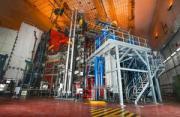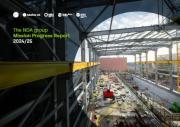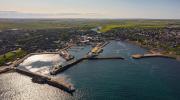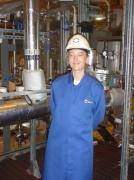Camera Team To Probe Underground Waste
29th September 2009
A decommissioning team is getting ready to look inside an underground bunker where intermediate-level radioactive waste has lain submerged in water for almost 40 years.
Two remotely-operated cameras will penetrate the concrete-lined vault in preparation for work starting to clean out its hazardous contents.
The two-week operation next month is expected to provide valuable images about the internal condition of the silo as well as state of the waste that was sent there.
The facility resembles a nine-metre deep swimming pool, lined on all sides with thick concrete and divided in the middle by a partition wall.
It was used by British scientists and engineers to take the radioactive waste from their experiments at Dounreay in the 20th century into more efficient ways to generate electricity from plutonium and uranium.
Much of the 750 tonnes of waste was metallic and included failed and redundant equipment, fuel element transit cans and debris from fuel element breakdown such as cladding, end fittings, wrappers and swarf. Other waste includes plastic, glass, paper and filters. It was filled with water to cool the waste and shield operators from its radiation.
The roof of the silo is at ground level and contained four posting ports that were used on more than 16,000 occasions from 1971 to drop waste into the water-filled vaults below.
The waste has lain undisturbed since the final consignment of waste was sent there in 1998.
"We'll drill through a metre of concrete in the roof to create two openings, each 150 millimetres in diameter," explained Derek Richardson, the engineer who looks after the facility.
"Two video cameras, together with lighting, will be lowered through the holes. One of them will look around at the condition of the structure while the other will be lowered into the water to look at the condition of the waste."
Controls will be put in place to guard against contamination. The drillholes will be plugged when the operation is over.
The water level in the silo has been lowered in recent months, with the surplus water cleaned up in a decontamination unit and discharged to the sea.
Dounreay Site Restoration Ltd, the company responsible for the clean-up and closure of Dounreay, has commissioned Clyde Valley Drilling to core the inspection holes using diamond cutting techniques.
Two Highland-based companies are providing the cameras - Kongsberg at Wick and Holland Engineering at Tomatin.
"It will probably take four of five days to core the roof of the silo," added project engineer Stuart Tod.
"The cores themselves will be useful, because their analysis will provide us with information about the structural integrity of the roof. This will be helpful to the engineers who design the equipment for removing the roof when the waste is retrieved from the silo."
Later this year, work is expected to begin on a scheme design for the equipment needed to retrieve waste from the silo and its predecessor, the nearby shaft.
Detailed designs will be ready by 2012, when construction companies worldwide are expected to bid for the contract to build the major plant needed to empty the two separate facilities.
The Silo
As the shaft filled up with intermediate-level waste, those in charge of the fast reactor experiment in the mid-1960s realised a second facility would be needed. In 1971, a new facility came into service - the ILW silo.
The silo is a concrete box set into the ground, with its roof just above ground level. It has a capacity of 720 cubic metres.
For the next 20 years, a variety of radioactive waste from every aspect of site operations was deposited in the silo through ports in the roof on more than 16,000 occasions.
Much of the waste was metallic and included failed and redundant equipment, fuel element transit cans and debris from fuel element breakdown such as cladding, end fittings, wrappers and swarf. Other waste includes plastic, glass, paper and filters.
The waste containers were moved into place above the posting ports using an overhead crane relocated from the shaft. Once secured, the base of the container was opened and the waste dropped into the silo.
In 1977, a cover building was constructed around the crane to give protection from the weather.
A second silo was constructed in the 1980s but never used. Standards had changed, and the site started to store this type of waste in drums stacked inside ventilated above-ground stores. The last disposal to the silo was in 1998.
The silo has always been partly filled with water to absorb some of the radiation. On occasions, more water was added to level the "pyramids" of waste that built up beneath the roof ports.
The overhead crane and cover building were dismantled in 2007.
Retrieval of waste from the silo will begin within the next decade. Robotic equipment will grab the waste and transfer it to a series of shielded handling cells where it will be checked, segregated and mixed with cement in steel drums that can be stored on-site as conditioned intermediate-level waste. Once empty, the silo can be decontaminated and demolished.
Related Businesses
Related Articles
TAE Technologies and UKAEA partner to commercialise fusion tech
Joint venture to develop neutral beams for fusion and non-fusion applications, creating high-skilled jobs and establishing a critical supply chain. TAE Technologies, a leading US private fusion energy firm with over 25 years at the forefront of scientific innovation, today announces a bilateral and reciprocal investment commitment with the United Kingdom's national fusion laboratory, the UK Atomic Energy Authority (UKAEA) to commercialise TAE's proprietary particle accelerator technology for the global market.
Buried Hazards, Unfinished Business - What the NDA's 2025 Progress Report Really Tells Us
The Nuclear Decommissioning Authority (NDA) has released its 2025 Mission Progress Report is a slightly sprawling document chronicling one of the UK's most complex environmental undertakings. The safe dismantling of its early nuclear legacy.
New recruit officers join the Civil Nuclear Constabulary
The Civil Nuclear Constabulary (CNC) welcomes its newest recruits. The CNC hosted two passing out parades for the graduating Authorised Firearms Officers (AFOs) of Initial Foundation Programme (IFP) 106.
Dounreay's next generation of talent honoured by apprentice award
Nuclear Restoration Services Dounreay's Kate Thomson has won Modern Apprentice of the Year at the Highlands & Islands Apprenticeship Awards in Inverness. Kate, who is in the second year of her apprenticeship in commercial and quantity surveying, said she was thrilled by the honour.
Taskforce calls for radical reset of nuclear regulation in UK
Nuclear Regulatory Taskforce publishes final report and calls for radical reset of overly complex nuclear regulatory system. An overly complex nuclear regulatory system has contributed to the "relative decline" of the UK's ability to deliver faster and cheaper nuclear projects.
Funding approved for Wick Harbour port consultant
A specialist ports consultant has been appointed to develop a long-term strategic plan for Wick Harbour Authority (WHA) in Caithness. WHA has secured £47,775 from Highlands and Islands Enterprise (HIE) and the Nuclear Restoration Services, NRS Dounreay towards the cost of the services.
Fallon Campbell From Melvich Near Thurso Named As Apprentice of the Year At Awards In London
Rising star from North Scotland honoured at event to celebrate brightest and best in industry. An electrical apprentice from North Scotland is celebrating after being recognised for her contribution to industry at the 13th annual Engineering Construction Industry ECI Training and Development Awards in London.
The NDA Group Graduate Programme: more than a job
The NDA group graduate scheme offers far more than just a stepping stone into the nuclear industry; it's a chance to grow professionally, explore new places, and become part of a supportive community. Nuala Ledward, Assurance and Performance Graduate, shares how her secondment to Dounreay brought these benefits to life.
UKAEA develops 3D printing for fusion components
At its recently opened Central Support Facility (CSF), UKAEA has commissioned an electron beam additive manufacturing machine that can be used to incorporate tungsten into components, alongside a selective laser manufacturing machine. Fusion can play a key role in a global low carbon energy future.Advancing Fusion Remote Maintenance: Industry Collaboration Driving Innovation
As part of the Fusion Futures (FF) programme, UKAEA's Remote Applications in Challenging Environments (RACE) has partnered with industry leaders to develop two groundbreaking technologies for remote maintenance in fusion energy engineering. Thanks to FF funding, industry has taken the lead in maturing UKAEA technology concepts—delivering real-world solutions that enhance operational autonomy and reduce maintenance burdens in extreme environments.
